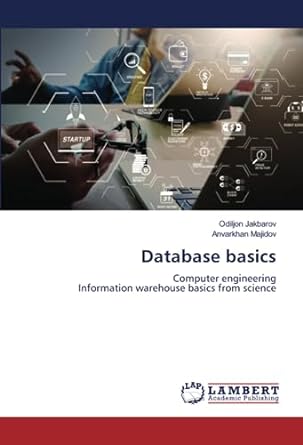Question
u can use whatever one you use and just save it as LabPart6.sql could you do the work and i plug the info in myself
u can use whatever one you use and just save it as LabPart6.sql could you do the work and i plug the info in myself
Write original seven queries using the database you created for Lab Part 5. Write one demonstrating your understanding of aggregate functions and set operators: AVE, CUBE ROLLUP, GROUPING, UNION, INTERSECT and MINUS.
For each query, write a question that the return set of the query answers in the space below. Place the sql for each query in a file named LabPart6.sql. Include a description of the query in the file.
Query 1
The query contains a subquery because a SELECT statement is coded within another SQL statement. The subquery is coded in the WHERE clause of the SELECT statement.
The query answers the question: What returned orders have reason Product Damaged?
Query 2
The query contains a subquery because a SELECT statement is coded within another SQL statement. The subquery is coded in the WHERE clause of the SELECT statement.
The query answers the question: What subquery orders have reason subquery ID?
Query 3
The query contains a subquery because a SELECT statement is coded within another SQL statement. The subquery is coded in the WHERE clause of the SELECT statement.
The query answers the question: What returned orders have reason number of IDs?
Query 4
The query contains a join because a SELECT statement is coded within another SQL statement. The join is coded in the join clause of the SELECT statement.
The query answers the question: What from orders the order ID?
Query 5
The query contains a subquery because a SELECT statement is coded within another SQL statement. The subquery is coded in the join clause of the SELECT statement.
The query answers the question: What from orders have reason order ID?
Query 6
The query contains a distinct because a SELECT statement is coded within another SQL statement. The distinct is coded in the WHERE clause of the SELECT statement.
The query answers the question: What from to date orders have reason 2016?
2016 is greater than the selected distinct
Query 7
Only those clients who have not order any product whose Name %Product%. The c_no column for the outer query table, customer, have relation to c_no column for the c_order table for the sub query.
Step by Step Solution
There are 3 Steps involved in it
Step: 1

Get Instant Access to Expert-Tailored Solutions
See step-by-step solutions with expert insights and AI powered tools for academic success
Step: 2

Step: 3

Ace Your Homework with AI
Get the answers you need in no time with our AI-driven, step-by-step assistance
Get Started


